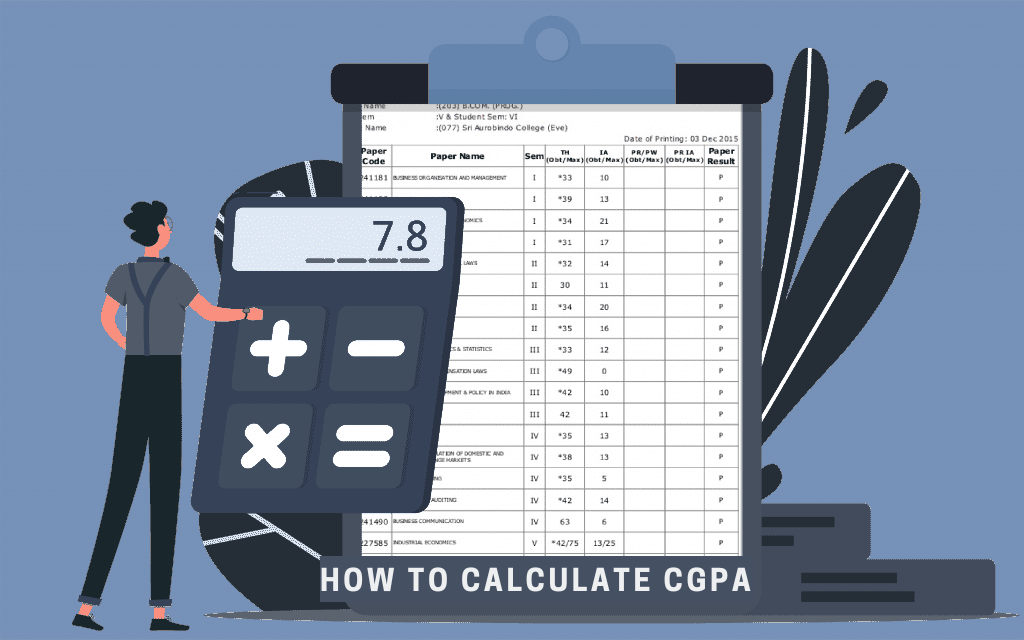When you search for How to Calculate CGPA, the first thing to know is that CGPA means Cumulative Grade Point Average. It is a number that sums up your overall academic performance across all semesters or courses instead of only one term.
This method of calculation helps both students and institutions see long-term progress. Rather than focusing on just one high or low score, CGPA balances your results and shows consistency over time.
Why CGPA Matters
CGPA plays several important roles:
- It gives a big-picture view of your academic journey. If you improve over semesters, CGPA reflects that growth.
- It is used for graduation requirements in many colleges: you need a minimum CGPA to graduate.
- Admissions and scholarships often consider CGPA. A high CGPA can help with entry into advanced programs or qualify you for financial aid.
- For employers, especially fresh graduates, CGPA can be a quick indicator of how dependable or disciplined you are academically.
CGPA vs GPA — What’s the Difference
You will often come across the terms GPA and CGPA, and while they sound similar, they do not mean the same thing. GPA, or Grade Point Average, measures a student’s performance in a single semester or term. It tells you how well you did in just that one part of your studies. CGPA, or Cumulative Grade Point Average, takes into account all the semesters or courses you have completed.
To put it simply, GPA is like reading a single chapter of a book, while CGPA is like understanding the whole book. Both are useful, but they serve different purposes. GPA helps you track progress semester by semester, while CGPA helps others, such as universities and employers, judge your overall academic performance.
The Scale — How Grades Turn Into Numbers
To calculate CGPA, you first need to understand the grading scale your institution uses. Different schools apply different systems, such as the 4.0 scale, the 5.0 scale, or the 10.0 scale. The process begins when your marks in a subject are converted into a letter grade such as A, B+, or C. Each letter then has a numerical value known as the grade point. For example, on a 4.0 scale, an A equals 4.0, while on a 10-point scale, an A could equal 10.
In addition to grades, courses usually carry credit hours or weight that show how important or demanding the subject is. For example, a science subject with labs may have more credits than a general elective. To get accurate results, you multiply the grade point you earned by the credit hours of the course. This gives you “quality points.” The CGPA is then calculated by combining these quality points across all courses.
Example Table: How to Calculate CGPA
| Subject | Marks Obtained (out of 100) | Grade | Grade Point | Credits | Quality Points (GP × Credits) |
|---|---|---|---|---|---|
| Mathematics | 88 | A | 9 | 4 | 36 |
| Science | 92 | A+ | 10 | 3 | 30 |
| English | 75 | B+ | 8 | 3 | 24 |
| History | 69 | B | 7 | 2 | 14 |
| Computer | 95 | A+ | 10 | 4 | 40 |
| Total | – | – | – | 16 | 144 |
Step-by-Step: How to Calculate CGPA
The process of calculating How to Calculate CGPA is straightforward once you know the method. Start by listing each course you have taken along with the credit hours assigned to it and the grade you received. Next, convert your grades into grade points according to the official scale. After that, multiply the grade point of each course by the number of credits it carries. This gives you the quality points for that course.
Once you have calculated quality points for all your courses, add them together to get the total quality points. Do the same for your total credits. The final step is to divide the total quality points by the total credits.

Example Calculation
Consider a student who completed four semesters with different credits and GPA scores. In the first semester, they took 15 credits and earned a GPA of 8.2. This gives them 123 quality points. In the second semester, 15 credits with a GPA of 9.0 result in 135 quality points. The third semester with 16 credits and an 8.5 GPA adds 136 quality points, and the fourth semester with 14 credits and a 9.2 GPA adds 128.8 quality points.
When you add all of these together, the student has 522.8 total quality points. Their total number of credits is 60. Dividing 522.8 by 60 gives a CGPA of 8.71 on a 10-point scale. This figure shows their consistent and strong performance across all semesters combined.
Converting CGPA to Percentage
Sometimes students or job applicants are required to present their scores in percentage form rather than CGPA. To make this conversion, many institutions use a fixed multiplier. In India, for example, the common formula is Percentage = CGPA × 9.5. Using this method, a CGPA of 8.71 becomes approximately 82.75%.
It is important to note that this formula is not universal. Different schools and universities may use different conversion factors depending on their grading standards. Therefore, it is always best to check the official rule of your board or institution before making this conversion.
Things That Can Affect Your CGPA
Several factors can influence your How to Calculate CGPA. One of the biggest is course credits. A subject with higher credit hours will have a stronger effect on your average than a smaller elective course. Another factor is failing or repeating subjects. Some schools count failed courses as zero in the CGPA calculation, while others may allow you to retake the course and replace the grade.
The grading scale your institution uses also matters. A 4-point scale will produce different numbers compared to a 10-point scale, even if the student’s performance is the same. Finally, if you use semester GPAs to calculate your CGPA, you need to make sure that each semester is weighted correctly according to its credits.
What a Good CGPA Looks Like
The definition of a “good” How to Calculate CGPA varies across institutions and scales. On a 10-point scale, a CGPA above 8.5 or 9.0 is generally considered excellent. On a 4-point scale, a CGPA of 3.5 or higher is usually viewed as very strong. However, numbers are not everything. While CGPA reflects academic consistency, employers and universities also look at skills, extracurricular achievements, projects, and personality traits.
So, even if your CGPA is slightly lower than you hoped, you can still stand out by showing strength in other areas. Remember that education is about more than just scores—it’s about growth, adaptability, and overall development.
Best Practices to Maintain or Improve Your CGPA
If you want to maintain or improve your How to Calculate CGPA, focus on courses with higher credit hours since they impact your score the most. At the same time, don’t ignore smaller subjects because they still contribute to your total. If you have a bad semester, do not lose hope; instead, work on recovering in the next term.
Time management and planning are essential. Spread out your study schedule to avoid last-minute cramming, which often leads to stress and poor performance. Ask for help when needed, whether from teachers, peers, or tutors. Above all, be consistent. Regular effort is more effective than bursts of intense study right before exams. This consistency will reflect in your CGPA and help you achieve steady academic success.
Final Thoughts
In summary, How to Calculate CGPA is a powerful metric for tracking long-term academic performance. Calculated correctly, it tells you (and others) how consistently you’ve performed over all your courses and semesters. It’s more comprehensive than just one semester’s GPA, and many schools, universities, employers use it as a baseline to assess you.
Before you calculate your CGPA, always check your institution’s rules: what scale they use, how they treat failed or repeated subjects, how credit weights are assigned. Once you know those, use the formula carefully and you’ll have a solid, accurate number that reflects your academic journey.
FAQs
Q1: What does CGPA mean in education?
A: CGPA stands for Cumulative Grade Point Average, and knowing how to calculate CGPA helps measure overall academic performance.
Q2: How to Calculate CGPA from grades?
A: To know how to calculate CGPA, add all grade points of subjects and divide by the number of subjects.
Q3: Can I convert CGPA into percentage?
A: Yes, once you know how to calculate CGPA, you can multiply it by 9.5 (or your board’s rule) to get percentage.
Q4: Why is it important to learn how to calculate CGPA?
A: Learning how to calculate CGPA is important because it helps track progress, apply for jobs, or scholarships.
Q5: Is the method of how to calculate CGPA the same worldwide?
A: The basic idea of how to calculate CGPA is the same, but scales and conversion rules differ by country or university.

